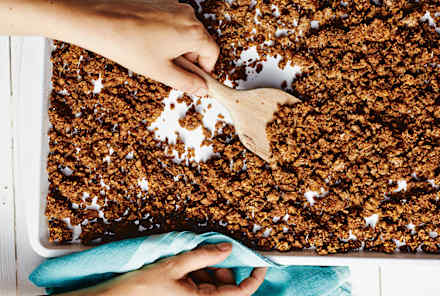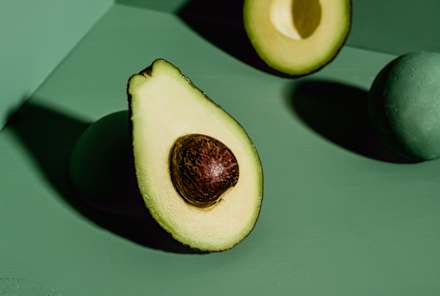Advertisement
Common Mistakes That Could Lead To 'Keto Crotch' & How To Avoid Them

We've all been there: a not-so-good odor coming from "down there." And the truth is, vaginal odor can happen for a variety of reasons—from yeast infections to STDs—but lately, reports are coming in from keto dieters that they are experiencing a particularly unpleasant vaginal odor after being on the popular ketogenic diet. It's been dubbed "keto crotch."
So, what's going on here?
For background, a ketogenic diet is one that's traditionally high in fat and low in carbohydrates, with adequate amounts of protein. As a result, foods such as breads, cereals, pasta, rice, and potatoes are essentially banned from this diet. Your cells then switch over from burning sugar to burning fat. Your body produces "ketone bodies" in the process, which are by-products of fat metabolism. When this happens, you are in ketosis, and your body is using fat as its primary fuel source in the absence of carbs.
One type of ketone body is acetone. You might know it best as an ingredient in some nail polish removers. When it accumulates in the body as a result of keto dieting, it can diffuse to your mouth. You may then experience another odor, dubbed "keto breath." It produces bad breath that smells not unlike your trusty nail polish remover.
This raises the question: Can ketones build up in your vaginal area, too, and emit an odor now being called "keto crotch"? Honestly, we doctors and scientists just don't know yet because there hasn't exactly been any scientific investigation into "keto crotch."
However, I'll tell you what I think. I believe "keto crotch" occurs because of a couple big mistakes we might unknowingly be making on the keto diet.
The biggest mistakes leading to "keto crotch" (and how to avoid them):
Not eating enough alkaline foods in your diet, which throws off vaginal pH.
A healthy vaginal pH is 3.5 to 4.5 pH, on the acidic end of the spectrum, which helps prevent the growth of certain microorganisms. But when you stay in ketosis for a long time, the ketones you're generating and the foods you're eating (particularly if you're loading up on acidic foods like meats, poultry, dairy, animal fats like butter, and caffeine) could be altering the pH of your vagina, possibly causing it to become more alkaline and allowing an overgrowth of bacteria—although we're not totally sure how. This overgrowth in microorganisms can cause an infection known as bacterial vaginosis (BV), characterized by a strong fishy vaginal odor and discharge—which may be what some people are calling "keto crotch."
So, what can you do about it? It may sound counterintuitive, but consuming more alkaline foods in your keto diet may help bring your vagina back down to its ideal acidic pH while simultaneously bringing your overall bodily pH back to its ideal slightly alkaline pH of 7.3 to 7.45 (which can be determined by testing your urine). While we don't know this for sure, I have a pretty strong suspicion based on my own trial and error.
Years ago, I'd put women on pure ketogenic diets. They loved the fast weight loss but hated certain side effects such as keto flu (which produces headaches, nausea, and general discomfort). Something had to change because these side effects made the diet hard to stick to. So I dug into some research and used myself as a guinea pig. I discovered that adding more alkaline foods to a keto diet made all the difference because it countered the acid-producing side effects of ketogenic dieting, which is how I came up with my alkaline-keto-style diet, which I call the Keto-Green Diet.
As I explain in my book The Hormone Fix, these alkaline foods include leafy greens and most other nonstarchy vegetables such as broccoli, cabbage, and Brussels sprouts; plant-based fats such as avocados, coconut oil, and olive oil; herbs like maca; and some fruits. An alkaline keto diet also places less emphasis on more acidic, animal-based fats—which have been found to1 increase bacterial vaginosis.
When I polled my own community of women enrolled in my online programs, only about 1 percent reported experiencing "keto crotch." I attribute this to the fact that they're following a keto-alkaline lifestyle, which helps keep infection-causing, odor-generating microorganisms in check by creating an ideal acid-alkaline balance throughout the body, including the vagina.
Not supporting your gut's population of "good" bacteria.
Research suggests2 that poorly formulated high-fat diets may alter the composition of the gut microbiome for the worse. And because the gut microbiome may function3 as a sort of "reservoir" for vaginal microorganisms, it's thought that keeping the gut healthy and balanced will help keep your vagina healthy and balanced, too—and likely reduce your likelihood of experiencing "keto crotch."
My suggestion: Include probiotic-based foods in your diet, such as yogurt, kimchee, and sauerkraut, as well as prebiotics (which feed the "good" probiotic bacteria in your gut) in the form of garlic, leeks, onions, and a variety of fiber-rich foods. These foods support a healthy vaginal pH, gut health, and immune function.
For further support, I recommend supplementing with a probiotic formulated with four of the most highly researched species: Bifidobacterium lactis, Bifidobacterium longum, Lactobacillus acidophilus, and Lactobacillus plantarum. The supplement should contain 30 billion CFUs (colony-forming units) of these strains. Take one dose prior to bedtime.
Additional tips if you're experiencing "keto crotch."
Besides eating a keto-alkaline diet and pumping up the probiotics, there are other important actions you can take to resolve "keto crotch":
- Do not douche. The vagina is self-cleansing—we don't have to help it. Douching flushes out good bacteria and only makes things worse. Without good bacteria, more of the bad bacteria are free to grow, and that's when you can get fishy odors down under.
- Use topical coconut oil. Rather than douche, use natural topical products to help counter vaginal odor. One of my favorites is coconut oil. It is very moisturizing and makes an excellent lubricant. What's more, it contains a compound called lauric acid that has antiviral, antibacterial, and antifungal properties. Just a small dab rubbed over the vulvar area is all you need.
- Test your urinary pH. Is your body overall more acid or alkaline? Find out by testing your urine first thing in the morning using pH strips that you can purchase at your pharmacy or online. The results are rapidly expressed as a color change. The greener the strip, the more alkaline your body. Pro tip: You want to have a pH of at least 7; anything less is acidic and signifies you may need to add more alkaline foods to your diet and scale back on acid-forming foods like meat, cheese, and animal fats.
- Consult your physician or gynecologist. If you're experiencing "keto crotch" or any sort of abnormal vaginal odor, please see your doctor to find out what's really going on. Don't be shy, either—vaginal odor is one of the biggest complaints we gynecologists hear from women, and usually, it's nothing to worry about. In some cases, this odor might indicate a vaginal infection such as BV (fishy smell with a white or gray discharge), a yeast overgrowth (no smell, or a bready or beer-like smell with white discharge), or an STD called trichomoniasis4 (putrid odor with a greenish discharge).
By following these tips, you can experience the benefits of a ketogenic diet without having to stress over funky vaginal odors.


















